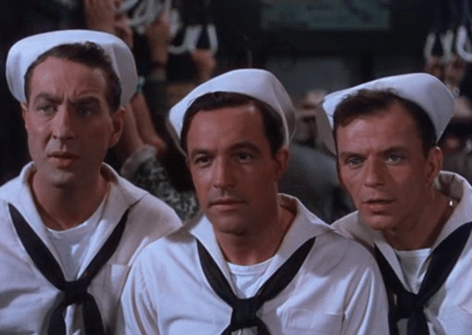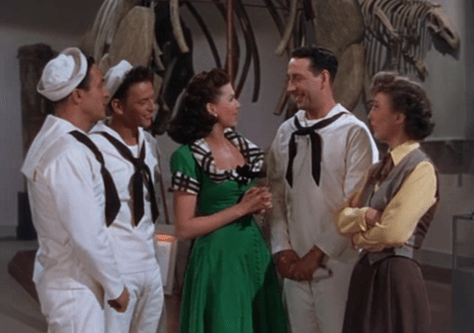
There is an immediate understanding that goes with the opening image of a construction worker arriving at the docks, still sleepy, as the world wakes up with him. And he does something that while still theatrical has roots in a very human urge, to bring in the new day with song.
If we look at the MGM catalog many of them have themes based around stage productions, film, or the arts. In their own way, such topics make completely logical sense as they make it much easier to transition into song and dance that feels pertinent to the performers in front of us. And yet when you think about it, at least for me, some of the most sublime of these old numbers are never connected with the big opulent stage productions being put on with giant routines.
Certainly, they are impressive for their scope and the intricacies of their execution, but where is the real magic? It’s Gene Kelly dancing in the rain because he’s in love and he’s got to articulate it. It’s Fred Astaire dancing on the ceiling overcome with joy of his own in Royal Wedding (coincidentally directed by Stanley Donen). And so when three sailors burst into view, scampering off their ship gleefully, with a whole day to gallivant around New York City, those emotions come across as incredibly genuine.
Gabey (Gene Kelly), Chip (Frank Sinatra), and Ozzie (Jules Munshin) break into a chorus of “New York, New York” no doubt heard all across town. Their subsequent adventure, tailored by the dynamic duo of Adolph Green and Betty Comden, truly is the quintessential, streamlined MGM musical.
It was plucked from the stage play dream team of choreographer Jerome Robbins and eminent composer Leonard Bernstein. The film itself was directed by Kelly and Donen who would maintain a fruitful yet increasingly bitter partnership together until It’s Always Fair Weather (1955). It’s nearly impossible to assume where one man’s influence began and the other’s ended. All we have are the results that speak for themselves.
Maybe I’m simply a sucker for ambling films like this where the prospects seem endless. Because, after an initial clip show and a decent amount of on-location footage, taking them all over, the boys finally settle on the fact that they need to find some girls while they’re in the big city.
Kelly is especially girl crazy when he spies, “Miss Turnstiles” (Vera-Ellen), plastered all over the Subway on posters, only to run across her moments later, getting her picture taken nearby. She’s quick to head off to her next engagement, and yet he’s immediately smitten and intent on reuniting with this beautiful, cultured girl who seems way out of his league.
Meanwhile, Sinatra is the one intent on seeing the sights. Much like Take Me Out to The Ball Game, he feels miscast in the naive role as their lady cabbie (Betty Garrett) chases after him, all but chauffeuring them around town free of charge as long as she’s compensated in male companionship. Poor Chip finds himself forced into the front seat constantly subjected to the lady’s amorous assaults. He’s a goner.

As the search for the local celebrity continues, Ozzie runs into Claire (Ann Miller), a woman conducting research at the Museum of Anthropological History, ceaselessly fascinated with prehistoric man,which Ozzie seems to be a perfect descendant of. It seems like everyone else is striking it rich as Gabey searches hopefully. And in its most movie-like moment, he’s rewarded for his tireless casing of the city. Sure enough, he wanders in on her as she balances on her head as nice you please.
It turns out that Ivy Smith is more of a girl-next-door than a big-name socialite and yet when Gabey finally tracks her down, she leads him on, playing the part to impress him. They solidify their chemistry with the winsome “Main Street,” personifying a universal portrait of small-town American, pretty girls, and light-hearted, good-natured romance. Later, their swiveling and maneurving on a ballet barre somehow manages to be seamless while further instilling their relationship.
Like all fated New York romances, a rendezvous for the top of the Empire State Building is planned. It’s a party! It also provides the backdrop for the deceptively romantic “You’re Awful,” allowing Sinatra to break out of his film persona for just one moment to croon as only he can croon. Betty Garrett proves she’s far more than a cab-driving clown, with tenderness to give as well.
Now everyone is together. You have the three sailors and their three All-American gals, each wonderfully color coordinated in bright Technicolor-worthy dresses and we finally feel as if things are complete.
The sense of camaraderie by this point is undeniable, and along with the New York setting, On The Town is bolstered by such a sentiment. Not only does it mean that we have a plethora of quality performers, but there’s a sense that they’re all in on this big beautiful extravaganza together, and they all have something to bring to the party. It makes for a delightful showing.

“You Can Count on Me,” says as much even as Gabey’s Cinderella rushes off without an explanation and his friends find it necessary to cheer him up.
“A Day in New York — A Comedy in Three Acts” seems a rather strange aside, and yet here you see an instance where Kelly (and Donen) gets to exercise a specific vision, aided by dancer/choreographers Carol Haney and Jeanne Coyne. Because this whole film is an ensemble piece and still, even this single scene shows glimpses of some of Kelly’s more inventive numbers ,which would come to fruition in the near-future. Again, deciphering the dividing line between Kelly, Donen, and the involvement of others is nearly impossible. But why bother with quibbling at this point? The results speak for themselves.
When the storyline wraps up and the three sailors have to bid adieu to their girls, the bittersweet melancholy of saying goodbye is unavoidable as is the continuity of life. Even on the way out, a new group of sailors is already bursting forth to see New York — the same crane operator observing their eagerness with a smile. The daily cycle begins again. What a city it is! Such a wonderful town. In fact, “Ol’ Blues Eyes” would sing about it again one day.
4/5 Stars




